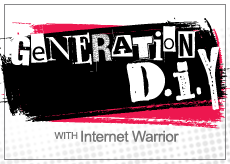Generation DIY: Cover Songs 101
posted in: Features
 The other week I attended the New Found Glory/Saves The Day concert at the House of Blues in Boston, MA. Being a fan of both artists since their inception, I’ve collected the entirety of their respective discographies. New Found Glory put out an EP in 2000 called From the Screen to Your Stereo which consisted of 7 cover tracks of national artists used in motion pictures (in 2007 they released the follow-up album From the Screen to Your Stereo II ¦ clever huh?). In the history of music, many bands have recorded and released covers of their favorite artists, or of songs that they believed the public would enjoy (something played on Top 40 to gain more recognition in most cases). So, in this week’s “Generation DIY,” I’d like to talk about the process of covering a song and the legality behind doing so.
The other week I attended the New Found Glory/Saves The Day concert at the House of Blues in Boston, MA. Being a fan of both artists since their inception, I’ve collected the entirety of their respective discographies. New Found Glory put out an EP in 2000 called From the Screen to Your Stereo which consisted of 7 cover tracks of national artists used in motion pictures (in 2007 they released the follow-up album From the Screen to Your Stereo II ¦ clever huh?). In the history of music, many bands have recorded and released covers of their favorite artists, or of songs that they believed the public would enjoy (something played on Top 40 to gain more recognition in most cases). So, in this week’s “Generation DIY,” I’d like to talk about the process of covering a song and the legality behind doing so.
So let’s first talk about music publishing. This is a very important component in the entertainment industry but we will stick to the basics and solely focus on cover songs. As said before, most to all covers are originally written by established artists but remember no matter what the song you cover and record, it does NOT belong to you. This is where the business side of things come into play. Music publishers such as ASCAP, BMI or SESAC, own the songs and pay out their artists whenever their song is used in commercial or distributed in one way or another” such as a young band covering a song and making it available for download on iTunes (which you will also need permission to do). It’s important to always remember you will have to pay certain fees when distributing a cover song for an income.
Let’s take a further step back and talk about the differences between a “sound recording” and a “composition.” Most of you may know the answer to this, but if you do not then listen up. Make a note that the word “composition” and “song” are interchangeable. They are the exact same thing, however a “sound recording” (or sometimes referred to as the “master”) is a different entity to the actual song. In terms of a cover, once you record a song (let’s say of Bon Jovi’s It’s My Life) you own the “sound recording” of your version. However, the “composition/song” or “work” is still owned by Bon Jovi or their music publishing company (depends on the deal, but we won’t go into that today). It all boils down to copyright. You can visit the government copyright page to get a better understanding of copyright laws. But for now look at songs (not to mention books, movies, paintings, etc.) intellectual property. As I said previously, you do need permission or “mechanical license” to reproduce your cover and offer it to the music community. To acquire a mechanical license, contact the owner of the composition and request permission to release your cover, which will then be charged a rate based on the publishing deal (the standard mechanical rate is 9.1 cents [$.091] per copy). It will benefit you to do some homework on the ASCAP, BMI and SESAC web sites, as well as The Harry Fox Agency that administers music-publishing rights for many songwriters and publishers. This may be the company that you go through to attain a mechanical license.
Now that didn’t seem too bad right? I know there is a lot to go through, and we only hit the basics”just skimmed the surface really but there are many books out in local bookstores, like Borders and Barnes & Noble, that you can read up on Music Publishing. For now, I’ll put together a set of links for you to peruse and learn more about at your leisure. If you have questions, feel free to leave a comment. I will do my best to help answer them.
Until next time Generation DIY. Keep your hustle strong. This is YOUR year.
Musicians: Check out these great companies and all they have to offer:
SESAC
BMI
ASCAP
The Harry Fox Agency
Also, for any further reading you can check out this great list of definitions I found online.
Music Publishing Definitions
Fun Fact: Did you know that the most covered song is “Yesterday” by The Beatles?
The More You Know.
